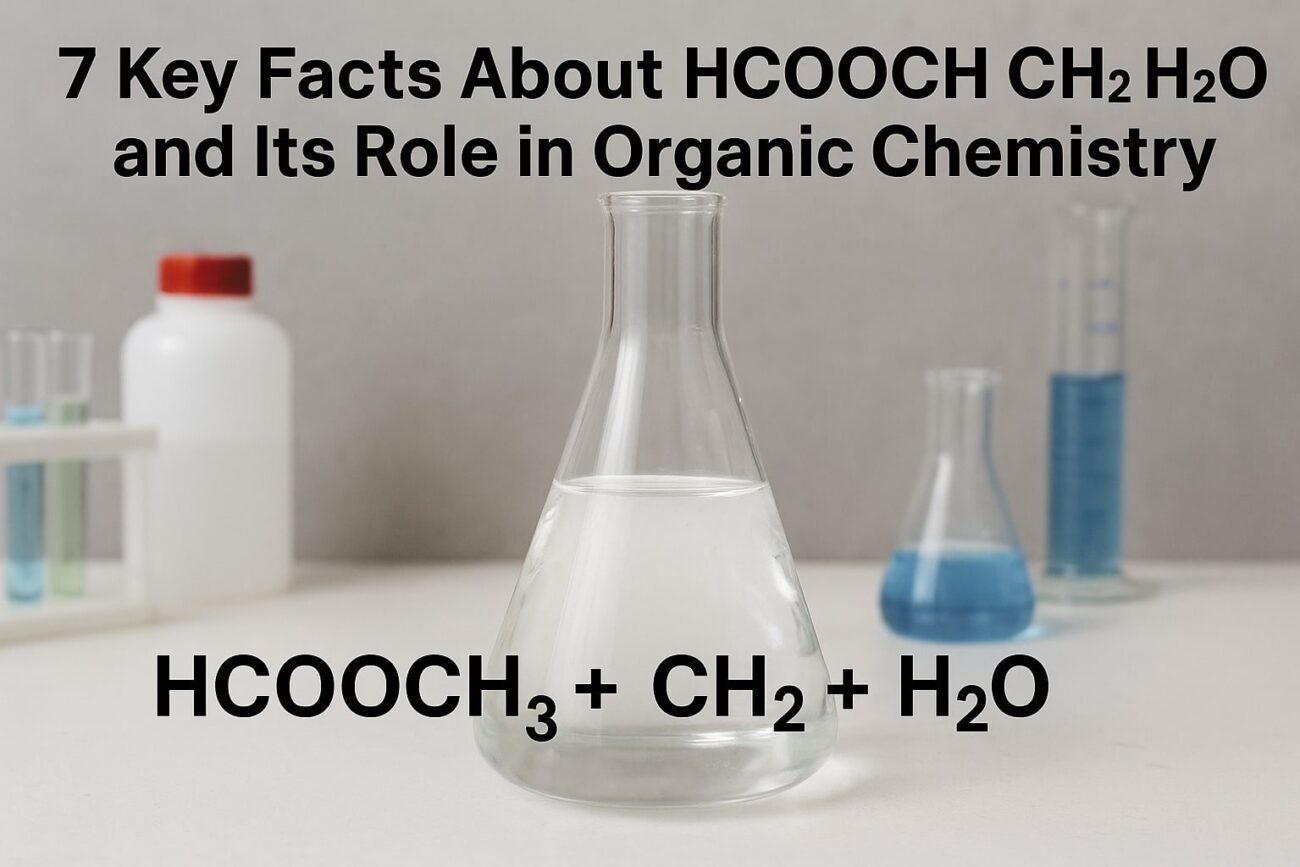Chemistry often looks complicated when written in formulas, and HCOOCH CH₂ H₂O is a good example. At first glance, this formula may seem confusing, but it actually represents the chemical behavior of methyl formate (HCOOCH₃) in the presence of water (H₂O) and a methylene group (CH₂).
In simple terms, this combination helps us understand how esters like methyl formate break down through hydrolysis and why the resulting products are important in industry, research, and environmental science.
Breaking Down The Formula
To make sense of HCOOCH CH₂ H₂O, let’s identify the parts:
- HCOOCH₃ (Methyl Formate): An ester with a pleasant, ether-like smell, commonly used as a solvent and chemical intermediate.
- CH₂ (Methylene Group): A basic carbon fragment often found in organic reactions.
- H₂O (Water): The universal solvent, and the key to hydrolysis reactions.
Together, these components highlight the way esters react with water, often with the involvement of reactive carbon groups like CH₂.
The Hydrolysis Reaction
The most significant reaction here is the hydrolysis of methyl formate:
HCOOCH₃ + H₂O → HCOOH + CH₃OH
- Methyl formate (HCOOCH₃) reacts with water (H₂O)
- Producing formic acid (HCOOH) and methanol (CH₃OH)
This reaction shows how a relatively simple ester can yield two highly useful chemicals.
Why This Reaction Matters
The chemistry behind HCOOCH CH₂ H₂O is more than just textbook science. It has real-world applications across multiple fields:
Industrial Applications
- Formic acid is used in textiles, leather treatment, food preservation, and agriculture.
- Methanol is crucial in the production of plastics, fuels, and pharmaceuticals.
Environmental Relevance
- Hydrolysis reactions like this occur naturally in water systems, helping scientists understand how certain compounds break down in the environment.
- Methyl formate itself has been studied as a green chemistry intermediate, since it can be synthesized from carbon monoxide and methanol with relatively low environmental impact.
Academic And Research Value
- The hydrolysis of esters, including methyl formate, is a teaching model in organic chemistry, demonstrating how functional groups react with water under different conditions.
Conditions That Influence The Reaction
The breakdown of HCOOCH CH₂ H₂O doesn’t happen instantly. Several factors affect the process:
- Catalysts: Acidic or basic environments speed up hydrolysis.
- Temperature: Higher temperatures increase the rate of reaction.
- Pressure and solvents: Industrial processes often adjust these to maximize efficiency.
Safety Considerations
While the chemistry is useful, the substances involved require care:
- Methyl formate is flammable and should not be inhaled in concentrated amounts.
- Formic acid is corrosive and can irritate skin and eyes.
- Methanol is toxic if swallowed or inhaled, even in small amounts.
In laboratories or industrial settings, proper protective equipment, ventilation, and storage are essential.
Key Takeaways
- HCOOCH CH₂ H₂O highlights the hydrolysis of methyl formate in the presence of water.
- The products—formic acid and methanol—are vital in multiple industries.
- This reaction serves as both a practical industrial process and a teaching example in chemistry.
- Safe handling and controlled conditions are necessary to manage risks.
Conclusion
The chemical expression HCOOCH CH₂ H₂O might seem complex, but it represents one of the most fundamental reactions in organic chemistry: ester hydrolysis. By breaking down methyl formate with water, we obtain formic acid and methanol—two building blocks that power industries, research, and environmental studies.
Understanding this reaction not only deepens our knowledge of chemistry but also connects directly to real-world applications that impact everyday life.
FAQ’s:
What Does HCOOCH CH₂ H₂O Represent?
It refers to the reaction of methyl formate (HCOOCH₃) with water (H₂O), often involving a methylene group (CH₂). The main outcome is the hydrolysis of the ester.
What Is Produced When HCOOCH₃ Reacts With Water?
The products are formic acid (HCOOH) and methanol (CH₃OH).
Why Is This Reaction Important In Industry?
Formic acid and methanol are widely used in fuels, textiles, plastics, and agriculture, making this reaction valuable for large-scale chemical production.
Does The Reaction Need Special Conditions?
Yes. Hydrolysis is faster in the presence of acids, bases, or heat. Industrial setups often control temperature and catalysts to increase efficiency.
Is Methyl Formate Safe To Use?
Methyl formate is flammable and harmful if inhaled. Its products, formic acid and methanol, are corrosive and toxic. Proper safety measures are essential.
Hungry for more? Head over to my website for fresh articles.
7 Key Features Of Echostreamhub Every Creator Should Know In 2025
